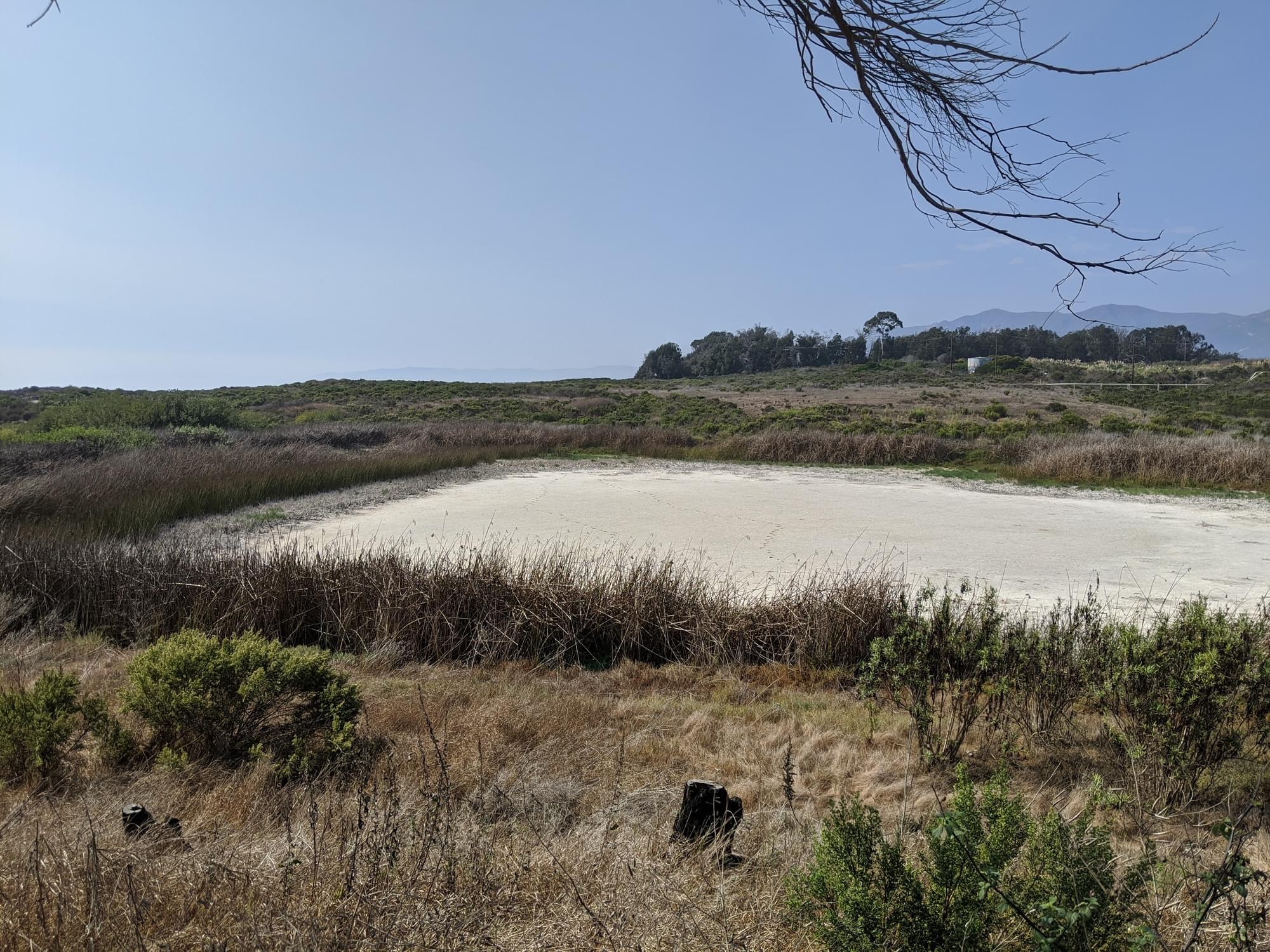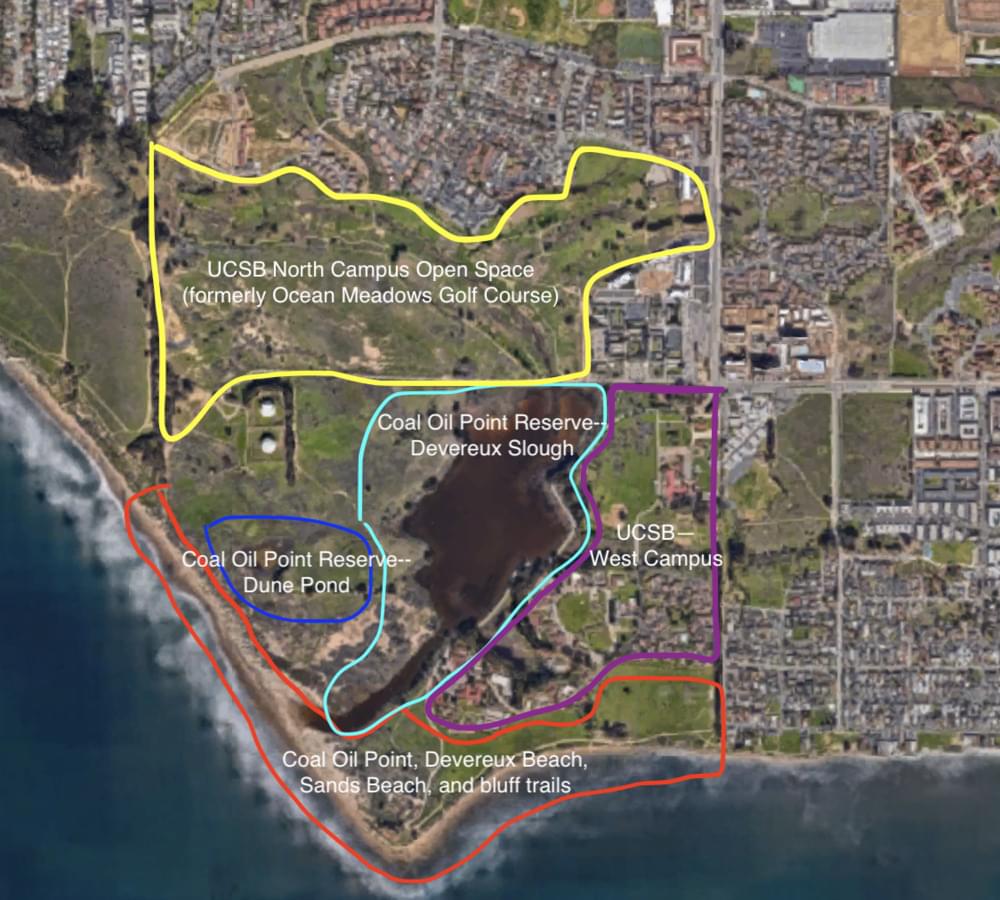Coal Oil Point Reserve--Dune Pond

Tips for Birding
It's a half-mile walk from almost any starting point, but worth the effort in all but the driest years.
Birds of Interest
As a stopover for migrating birds the Dune Pond is immensely important. When water is high it supports ducks, marsh species, coots, and grebes. When the water is low or receding, it supports shorebirds, sometimes in good numbers. In summer, approximately 14 species rely directly on the aquatic nature of the pond area for breeding and post-breeding support.
Green Heron bred in the Eucalyptus for 2 years (1997 and 1998) until the trees burned. At that time, we knew of only about 5 nests in the entire Santa Barbara County. In May 2005, Virginia Rail raised 3 chicks. Swamp Sparrow and Tropical Kingbird are not uncommon here in winter. Three species of ducks have bred here: Mallard and Ruddy Duck are nearly annual, and Gadwall occasionally.
About this Location
The Dune Pond at Coal Oil Point Reserve is the most historically intact of any coastal brackish wetland along the Santa Barbara County South Coast. Despite its small size, it supports almost as many breeding bird species and more individuals than does the much larger Devereux Slough. How could this be? Doesn’t size matter when it comes to wetlands in support of birds?
All Wetlands Are Not Equal. The hydrology of Devereux Slough is driven by winter runoff from the watershed impounded in the slough by the sandy berm at the beach. After rains and runoff fill the slough, evaporation concentrates salts in the water so that by May and June, the slough water becomes hyper-saline (much more saline than sea water). In Santa Barbara County, persistently salty conditions limit plant and insect diversity. The result is that Devereux Slough is relatively depauperate for many animals and it supports few breeding birds, if water is present at all, by the time most birds are breeding.
The hydrology of the Dune Pond is totally different. This sag pond is formed by an active geologic fault. Most water comes from the ground up rather than from the watershed down. The water feeding the Dune Pond remains fresh or brackish and, importantly, it provides standing water through the bird breeding period. Other than persistently flowing creeks and springs, no other natural freshwater habitat in Santa Barbara County behaves this way. These benign conditions support more diverse vegetation, which gives rise to more diverse animals than Devereux Slough. The differences in the workings of these two wetlands so close to each other are striking.
In this semi-desert region, the rare fresh/brackish water wetlands that persist into summer are by far the most productive habitats for birds.
Of course, in winter, both wetlands are dominated by fresh water, and both overflow with waterfowl activity.
About Devereux Slough Complex
See all hotspots at Devereux Slough Complex
Devereux Slough was once a larger and deeper estuarine wetland covering much of COPR and NCOS, with a permanent channel connected to Goleta Slough through what is now Isla Vista. It is fed by inputs from Devereux Creek (flowing through the Eucalyptus line in Ellwood Mesa), Phelps Creek (from the north, in the "North Parcel" restoration area), Whittier Channel (just west of the Whittier Parking Lot), and an eastern unnamed tributary.
In the 1861 water year, overgrazing combined with massive rainfall led to enormous sediment deposits in the Slough and turned it from a deep estuary into a salt marsh. During the 1960s, the northern portion of the Slough was artificially filled in to build Ocean Meadows Golf Coarse, which closed in 2013.
Now, the Slough alternates between tidal saltwater and pooling fresh or brackish water depending on the season. During most of the year, a sand berm where the Slough connects to Sands Beach prevents water from flowing into or out of the Slough. As the Slough fills with water during winter rains, it eventually breaks through the berm and empties into the ocean. For a period of several weeks it becomes tidal until the berm is reformed. From that point on, the Slough continues to fill until either it breaches again, or the rain stops for summer. During summer, the water in the Slough gradually evaporates, which causes the channel to become narrower and more saline. The process then repeats when winter rains return.
The southern portion of the Slough was named Coal Oil Point Reserve and incorporated into the University of California Natural Reserve System in 1970. Numerous University of California research projects have taken place at COPR over the last five decades. Active weeding programs use teams of volunteers and paid staff to maintain the natural grassland and scrub communities.
In 2017, UCSB's Cheadle Center for Biodiversity and Ecological Restoration purchased the former golf course to create a restoration site now known as North Campus Open Space. Restoration began in 2017 with substantial ground-moving efforts designed to produce salt marsh habitat that will be resilient to sea level change. The project is now nearing completion, and active restoration work on site will likely gradually slow over time.
Free parking is available for NCOS off of Whittier (34.4222, -119.8713). Parking is also available on COPR at (34.410822, -119.876781), but requires a UCSB parking permit or a day pass (paid at meters on site). Free street parking is available on Camino Majorca in western Isla Vista, which provides foot or bike access to COPR via the West Campus Bluffs Trails. A public portapotty is available by Coal Oil Point at (34.407781, -119.878912)
Features
Restrooms on site
Wheelchair accessible trail
Entrance fee
Roadside viewing
Content from Mark Holmgren, The Past, Present, and Future Hydrology of Devereux Slough, Coal Oil Point Reserve, North Campus Open Space, and Conor McMahon
Last updated December 7, 2023
 Devereux Slough Complex
Devereux Slough ComplexGoogle Maps; Linus Blomqvist